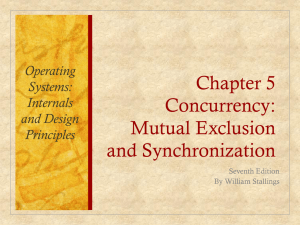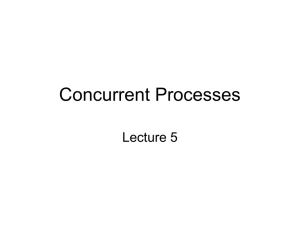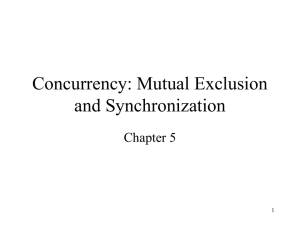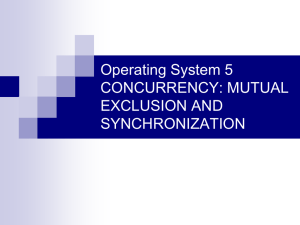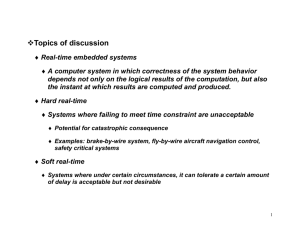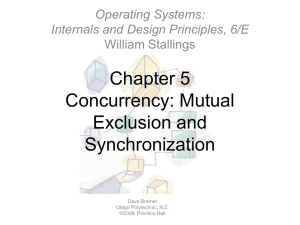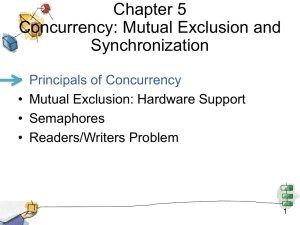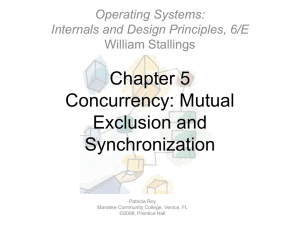Chapter 5 Concurrency: Mutual Exclusion and Synchronization
advertisement
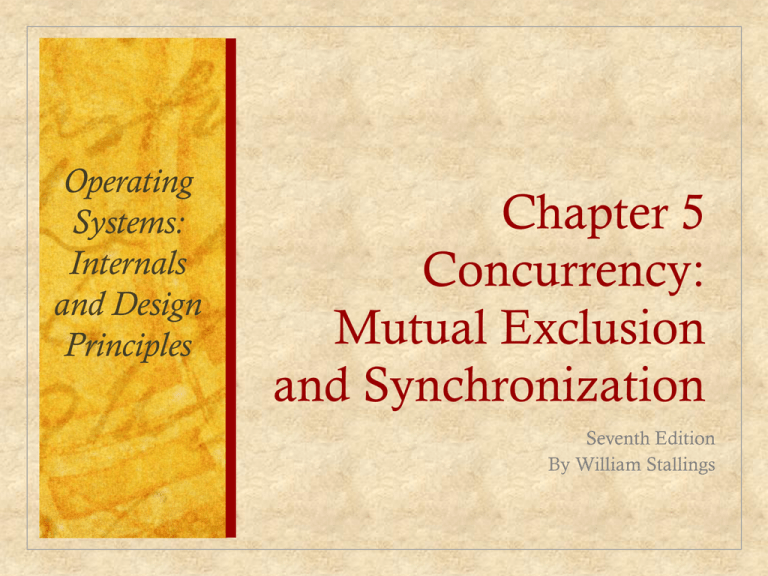
Operating
Systems:
Internals
and Design
Principles
Chapter 5
Concurrency:
Mutual Exclusion
and Synchronization
Seventh Edition
By William Stallings
“ Designing correct routines for controlling concurrent activities
proved to be one of the most difficult aspects of systems
programming. The ad hoc techniques used by programmers of
early multiprogramming and real-time systems were always
vulnerable to subtle programming errors whose effects could be
observed only when certain relatively rare sequences of actions
occurred. The errors are particularly difficult to locate, since the
precise conditions under which they appear are very hard to
reproduce.”
—THE COMPUTER SCIENCE AND
ENGINEERING RESEARCH STUDY,
MIT Press, 1980
Operating
System design is concerned
with the management of processes and
threads:
Multiprogramming
Multiprocessing
Distributed Processing
Multiple
Applications
invented to allow
processing time to
be shared among
active applications
Structured
Applications
extension of
modular design
and structured
programming
Operating
System
Structure
OS themselves
implemented as a
set of processes
or threads
Concurrency & Shared
Data
Concurrent
processes may share data to
support communication, info exchange,...
Threads
in the same process can share
global address space
Concurrent
For
sharing may cause problems
example: lost updates
Concurrency
K
e
y
T
e
r
m
s
Table 5.1 Some Key Terms Related to Concurrency
Interleaving and overlapping
can be viewed as examples of concurrent processing
both present the same problems
In multiprogramming, the relative speed of
execution of processes cannot be predicted
depends on activities of other processes
the way the OS handles interrupts
scheduling policies of the OS
Difficulties of Concurrency
Sharing
of global resources
Difficult
for the OS to manage the allocation
of resources optimally
Difficult
to locate programming errors as
results are not deterministic and
reproducible
Occurs
when multiple processes or
threads read and write shared data
items
The
final result depends on the order of
execution
the “loser” of the race is the process
that updates last and will determine the
final value of the variable
Operating System Concerns
Design and management issues raised by the existence of
concurrency:
The OS must:
be able to keep track of various processes
allocate and de-allocate resources for each
active process
protect the data and physical resources of each process
against interference by other processes
ensure that the processes and outputs are independent
of the processing speed
P I
R N
O T
C E
E R
S A
S C
T
I
O
N
Resource Competition
Concurrent processes come into conflict when
they use the same resource (competitively or
shared)
for example: I/O devices, memory, processor time, clock
Three control problems must be faced
Need for mutual exclusion
Deadlock
Starvation
Sharing processes also need to address coherence
Need for Mutual Exclusion
If there is no controlled access to shared data,
processes or threads may get an inconsistent
view of this data
The result of concurrent execution will depend
on the order in which instructions are
interleaved.
Errors are timing dependent and usually not
reproducible.
A Simple Example
Assume P1 and P2 are executing
this code and share the variable a
Processes can be preempted at any
time.
Assume P1 is preempted after the
input statement, and P2 then
executes entirely
The character echoed by P1 will be
the one read by P2 !!
static char a;
void echo()
{
cin >> a;
cout << a;
}
What’s the Problem?
This is an example of a race condition
Individual processes (threads) execute
sequentially in isolation, but concurrency causes
them to interact.
We need to prevent concurrent execution by
processes when they are changing the same data.
We need to enforce mutual exclusion.
The Critical Section
Problem
When a process executes code that manipulates
shared data (or resources), we say that the
process is in its critical section (CS) for that
shared data
We must enforce mutual exclusion on the
execution of critical sections.
Only one process at a time can be in its CS (for
that shared data or resource).
The Critical Section Problem
Enforcing mutual exclusion guarantees that
related CS’s will be executed serially instead of
concurrently.
The critical section problem is how to provide
mechanisms to enforce mutual exclusion so the
actions of concurrent processes won’t depend on
the order in which their instructions are
interleaved
The Critical Section Problem
Processes/threads must request permission to
enter a CS, & signal when they leave CS.
Program structure:
entry section: requests entry to CS
exit section: notifies that CS is completed
remainder section (RS): code that does not involve
shared data and resources.
The CS problem exists on multiprocessors as well
as on uniprocessors.
Mutual Exclusion and Data
Coherence
Mutual Exclusion ensures data coherence if
properly used.
Critical Resource (CR) - a shared resource such as
a variable, file, or device
Data Coherence:
The final value or state of a CR shared by concurrently executing processes
is the same as the final value or state would be if each process executed
serially, in some order.
Deadlock and Starvation
Deadlock: two or more processes are blocked
permanently because each is waiting for a
resource held in a mutually exclusive manner by
one of the others.
Starvation: a process is repeatedly denied access
to some resource which is protected by mutual
exclusion, even though the resource periodically
becomes available.
Mutual Exclusion
Figure 5.1
Illustration of Mutual Exclusion
Mutual Exclusion: must be enforced
Non interference: A process that halts must not
interfere with other processes
No deadlock or starvation
Progress:A process must not be denied access to a critical
section when there is no other process using it
No assumptions are made about relative process speeds
or number of processes
A process remains inside its critical section for a finite
time only
– uniprocessor system
– disabling interrupts
guarantees mutual
exclusion
– the efficiency of
execution could be
noticeably degraded
– this approach will not
work in a multiprocessor
architecture
Special
Machine Instructions
Compare&Swap
Instruction
also called a “compare and exchange
instruction”
a compare is made between a memory value
and a test value
if the old memory value = test value, swap in a
new value to the memory location
always return the old memory value
carried out atomically in the hardware.
Compare&Swap
Instruction
Pseudo-code definition of the
hardware instruction:
compare_and_swap (word, test_val, new_val)
if (word ==test_val)
word = new_val;
return new_val
word = bolt
test_val = 0
new_val = 1
If bolt is 0 when
the C&S is
executed, the
condition is false
and P enters its
critical section.
(leaves bolt = 1)
If bolt = 1 when
C&S executes, P
continues to
execute the
while loop. It’s
busy waiting ( or
spinning)
Figure 5.2 Hardware Support for Mutual Exclusion
Exchange Instruction
Figure 5.2 Hardware Support for Mutual Exclusion
Applicable to any number of processes on
either a single processor or multiple
processors sharing main memory
Simple and easy to verify
It can be used to support multiple critical
sections; each critical section can be defined
by its own variable
Special Machine Instruction:
Disadvantages
Busy-waiting is employed, thus while a
process is waiting for access to a critical
section it continues to consume processor
time
Starvation is possible when a process
leaves a critical section and more than one
process is waiting
Deadlock is possible if prioritybased scheduling is used
Semaphore
A variable that has an
integer value upon
which only three
operations are
defined:
There is no way to
inspect or manipulate
semaphores other than
these three operations
1) May be initialized to a nonnegative integer value
2) The semWait operation decrements the value
3) The semSignal operation increments the value
Consequences
There is no way to
know before a
process decrements
a semaphore
whether it will
block or not
There is no way to
know which process
will continue
immediately on a
uniprocessor system
when two processes
are running
concurrently
You don’t know
whether another
process is waiting so
the number of
unblocked processes
may be zero or one
Semaphore Primitives
Binary Semaphore Primitives
A queue is used to hold processes waiting on the semaphore
Strong Semaphores
• the process that has been blocked the longest is
released from the queue first (FIFO)
Weak Semaphores
• the order in which processes are removed from the
queue is not specified
Producer/Consumer Problem
General
Situation:
• one or more producers are
generating data and
placing these in a buffer
• a single consumer is
taking items out of the
buffer one at time
• only one producer or
consumer may access the
buffer at any one time
The Problem:
• ensure that the
producer can’t add
data into full
buffer and
consumer can’t
remove data from
an empty buffer
Buffer Structure
Figure 5.9 An Incorrect Solution to the Infinite-Buffer Producer/Consumer Problem Using Binary Semaphores
Figure 5.10 A Correct Solution to the Infinite-Buffer Producer/Consumer Problem Using Binary Semaphores
S
o
l
u
t
i
o
n
U
s
i
n
g
S
e
m
a
p
h
o
r
e
s
S
o
l
u
t
i
o
n
U
s
i
n
g
S
e
m
a
p r
h e
o s
Figure 5.13 A Solution to the Bounded-Buffer Producer/Consumer Problem Using Semaphores
Implementation of
Semaphores
Imperative
that the semWait and
semSignal operations be implemented as
atomic primitives
Can
be implemented in hardware or firmware
Software
schemes such as Dekker’s or
Peterson’s algorithms can be used
Use
one of the hardware-supported
schemes for mutual exclusion
Review
Concurrent processes,
threads
Access to shared
data/resources
Need to enforce mutual
exclusion
Hardware mechanisms
have limited usefulness
Semaphores: OS
mechanism for mutual
exclusion & other
synchronization issues
Standard
semaphore/counting
Binary semaphore
Producer/consumer
problem
Monitors
Programming language construct that provides
equivalent functionality to that of semaphores and is
easier to control
Implemented in a number of programming
languages
including Concurrent Pascal, Pascal-Plus, Modula-2,
Modula-3, and Java
Has also been implemented as a program library
Software module consisting of one or more
procedures, an initialization sequence, and local
data
Monitor Characteristics
Local data variables
are accessible only
by the monitor’s
procedures and not
by any external
procedure
Only one process
may be executing in
the monitor at a
time
Process enters
monitor by invoking
one of its
procedures
Synchronization
Achieved by the use of condition variables that are
contained within the monitor and accessible only
within the monitor
Condition variables are operated on by two
functions:
cwait(c): suspend execution of the calling process on
condition c
csignal(c): resume execution of some process blocked
after a cwait on the same condition
Figure 5.15 Structure of a Monitor
Figure 5.16 A Solution to the Bounded-Buffer Producer/Consumer Problem Using a Monitor
When processes interact with one another two
fundamental requirements must be satisfied:
synchronization
• to enforce mutual
exclusion
communication
• to exchange
information
Message Passing is one approach to providing both
of these functions
works with distributed systems and shared memory multiprocessor and
uniprocessor systems
Message Passing
The actual function is normally provided in the form
of a pair of primitives:
send (destination, message)
receive (source, message)
A process sends information in the form of a message
to another process designated by a destination
A process receives information by executing the
receive primitive, indicating the source and the
message
Message Passing
Table 5.5 Design Characteristics of Message Systems for Interprocess Communication and Synchronization
Both
sender and receiver are blocked until
the message is delivered
Sometimes
Allows
referred to as a rendezvous
for tight synchronization between
processes
Nonblocking Send
Nonblocking send, blocking receive
• sender continues on but receiver is blocked until the
requested message arrives
• most useful combination
• sends one or more messages to a variety of destinations as
quickly as possible
• example -- a service process that exists to provide a service
or resource to other processes
Nonblocking send, nonblocking receive
• neither party is required to wait
Schemes for specifying processes in send
and receive primitives fall into two
categories:
Direct
addressing
Indirect
addressing
Direct Addressing
Send primitive includes a specific identifier
of the destination process
Receive primitive can be handled in one of
two ways:
require that the process explicitly
designate a sending process
effective for cooperating concurrent processes
implicit
addressing
source parameter of the receive primitive possesses a
value returned when the receive operation has been
performed
Indirect Addressing
Messages are sent to a
shared data structure
consisting of queues that
can temporarily hold
messages
Allows for
greater flexibility
in the use of
messages
Queues are
referred to as
mailboxes
One process sends a
message to the mailbox
and the other process
picks up the message
from the mailbox
Mutual Exclusion
Message Passing Example
Figure 5.21 A Solution to the Bounded-Buffer Producer/Consumer Problem Using Messages
Readers/Writers Problem
A data area is shared among many processes
some processes only read the data area, (readers)
and some only write to the data area (writers)
Conditions that must be satisfied:
1. any number of readers may simultaneously
read the file
2. only one writer at a time may write to the file
3. if a writer is writing to the file, no reader
may read it
Readers Have Priority
S i
o o
l n
u
t
Figure 5.22 A Solution to the Readers/Writers Problem Using Semaphore: Readers Have Priority
Solution:
Writers Have Priority
Figure 5.23 A Solution to the Readers/Writers Problem Using Semaphore: Writers Have Priority
State of the Process Queues
Message Passing
Figure 5.24 A Solution to the Readers/Writers Problem Using Message Passing
Messages
• Useful for the enforcement of mutual exclusion discipline
Operating system themes are:
• Multiprogramming, multiprocessing, distributed processing
• Fundamental to these themes is concurrency
• issues of conflict resolution and cooperation arise
Mutual Exclusion
• Condition in which there is a set of concurrent processes, only one of
which is able to access a given resource or perform a given function
at any time
• One approach involves the use of special purpose machine
instructions
Semaphores
• Used for signaling among processes and can be readily used to enforce
a mutual exclusion discipline
